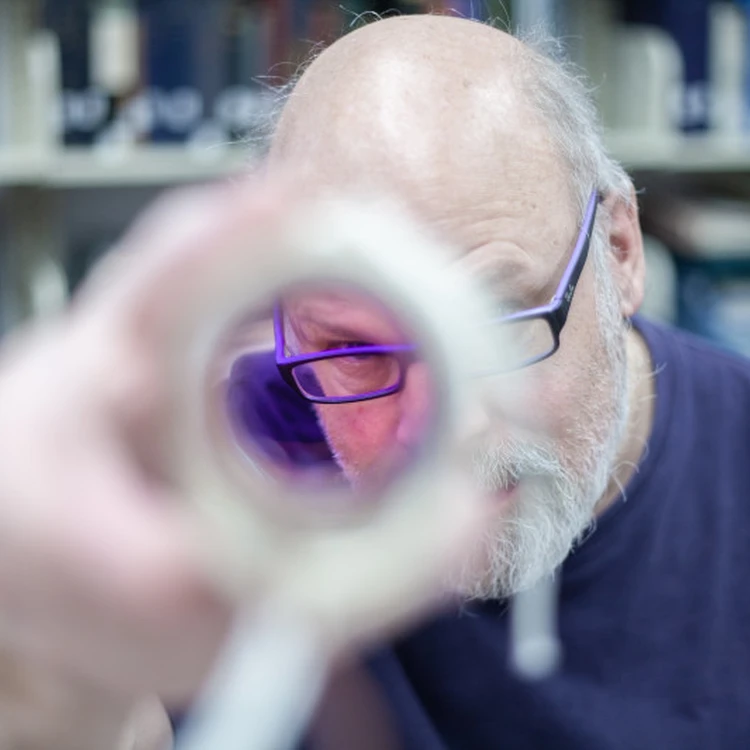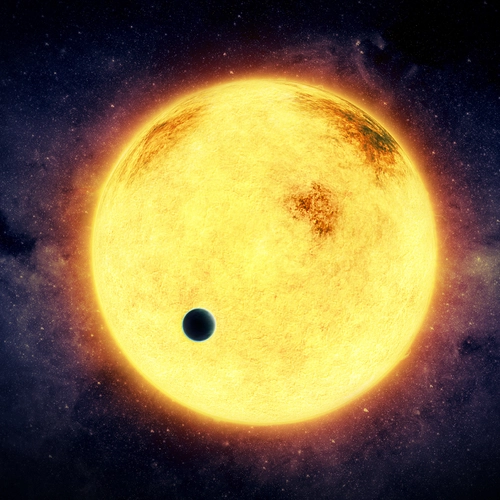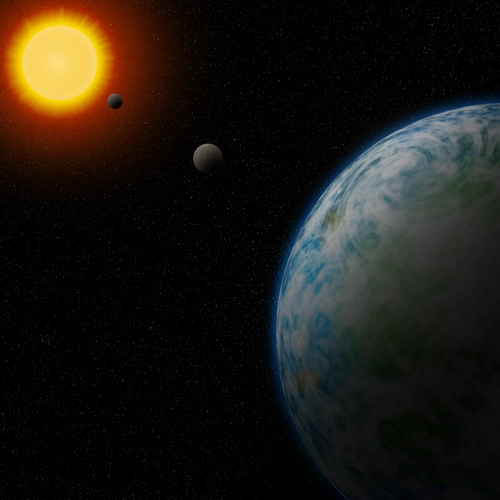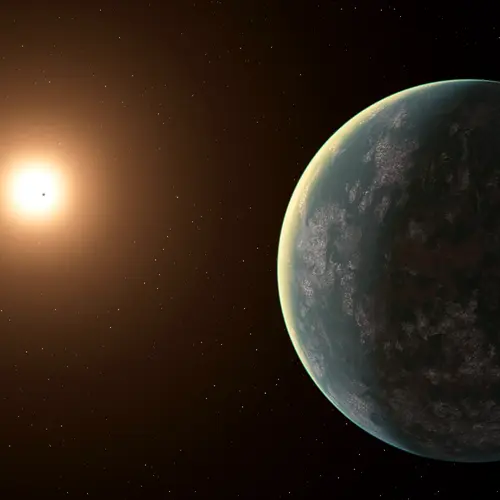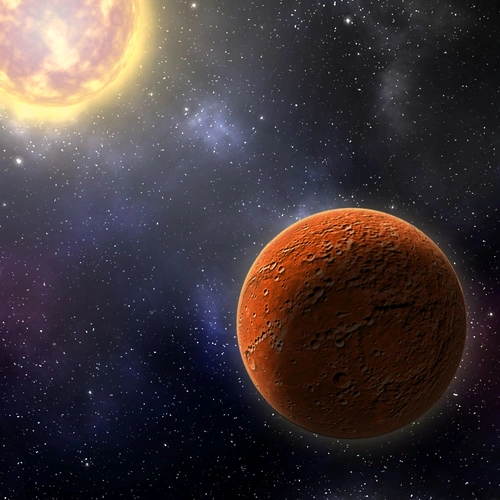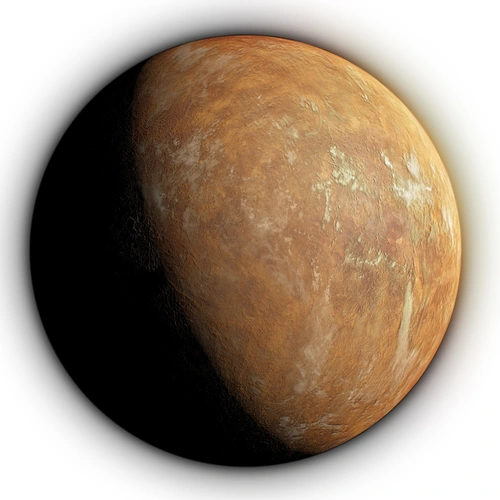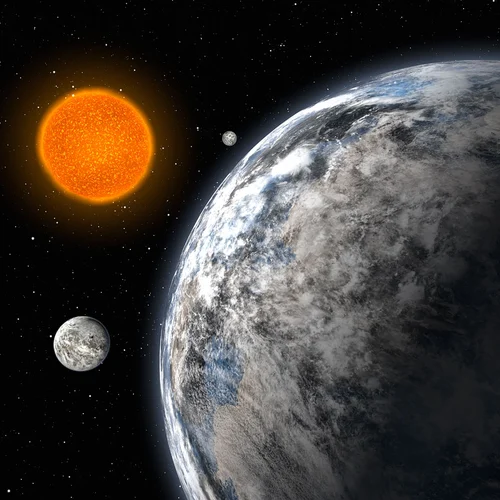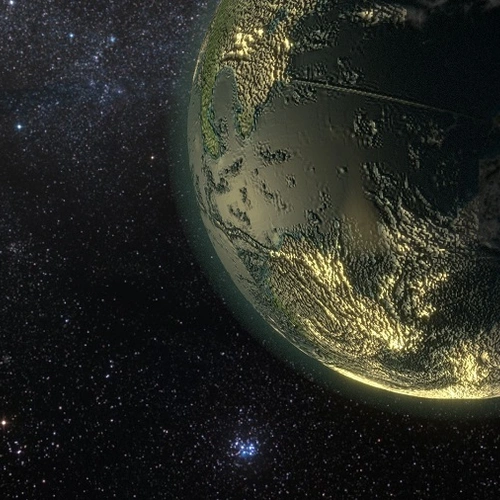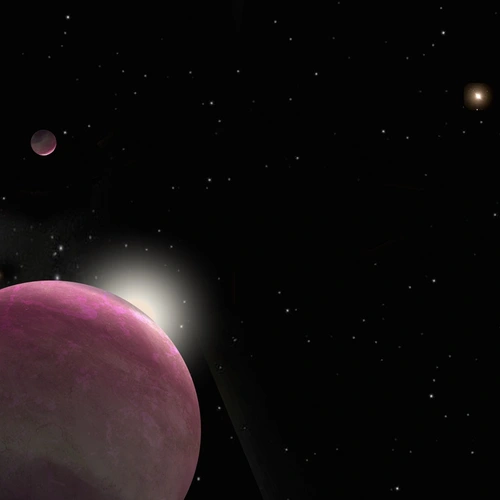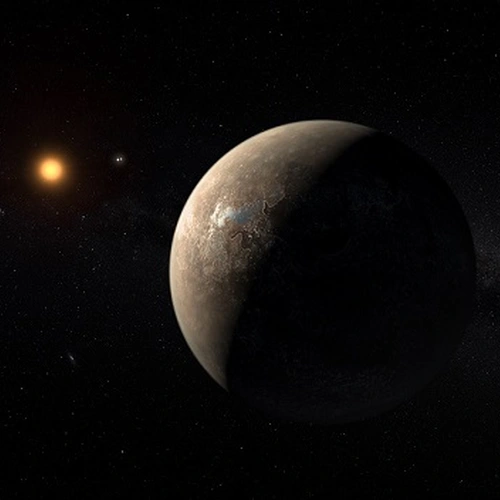Overview
Paul Butler designed and built the iodine absorption cell system at Lick Observatory, which resulted in the discovery of 5 of the first 6 known extrasolar planets. This instrument has become the de facto standard for precision Doppler studies, having been adopted by teams at the University of Texas, Harvard, Europe, and Japan. In addition, Butler built the iodine systems at the Keck, Anglo-Australian, and Magellan Telescopes. The original iodine cell (still in use at Lick) has been requested by the Smithsonian Institution upon its retirement.
Over the past 25 years, Butler's work has focused on improving the measurement precision of stellar Doppler velocities, from 300 meters per second in the 1980s to 1 meter a second in the 2010s to detect planets around other stars. The ultimate goal is to find planets that resemble the Earth.
Research
While the planets in our Solar System are astonishingly diverse, all of them move around the Sun in approximately the same orbital plane, in the same direction, and primarily in circular orbits. Over the past 25 years, Paul Butler's work has focused on improving the measurement precision of stellar Doppler velocities, from 300 meters per second in the 1980s to 1 meter a second in the 2010s to detect planets around other stars. The ultimate goal is to find planets that resemble the Earth.
Butler designed and built the iodine absorption cell system at Lick Observatory, which resulted in the discovery of 5 of the first 6 known extrasolar planets. This instrument has become the de facto standard for precision Doppler studies, having been adopted by teams at the University of Texas, Harvard, Europe, and Japan. In addition, Butler built the iodine systems at the Keck, Anglo-Australian, and Magellan Telescopes.
The original iodine cell (still in use at Lick) has been requested by the Smithsonian Institution upon its retirement.
Along with his collaborators at Lick, Keck, AAT, and Magellan, Butler has discovered hundreds of extrasolar planets, including the first planet to transit its host star, the first sub-Saturn mass planet, the first Neptune-mass planet, and the first terrestrial mass planet. This work has been featured in several front-page articles in the New York Times and Washington Post, as well as a TIME magazine cover story.
The Keck Observatory Planet Search Program discovered most of the first 200 exoplanets, including the first Neptune-mass planet and the first super-Earth. The final paper contains 60,949 Doppler velocity measurements covering 1,624 stars taken over 20 years. These are typically the nearest and brightest F,G,K, and M dwarf stars that can be seen from Mauna Kea.
Since Butler's team finalized the targets for the paper, they have continued to mine the NASA/Keck data archive for new data. Starting with the raw images, we generate a logsheet, reduce the raw images to 1-D spectra, and measure Doppler velocities from the spectra, all with our proprietary software. Our latest update includes 75,062 Doppler velocity measurements of 1,700 stars, through the beginning of the Covid lock-down, 10 March 2020.
View the DataFinding planets orbiting nearby stars has been a holy grail in astronomy for more than 400 years. Paul Butler and his team began working on this problem 30 years ago, at a time when there were no known extrasolar planets. In late 1995, they began to routinely find planets around Earth's nearest stars. Since then they have found several hundred planets, including the first sub-Saturn mass planet, the first Neptune mass planet, the first terrestrial mass planet, the first multiple-planet system, and the first transiting planet.
View the project
UVES is the high-resolution optical spectrograph of the Very Large Telescope in Chile.
When the UVES M Dwarf Planet Search program began in March 2000, fewer than 50 giant exoplanets were known, only one of which was hosted by an M dwarf. There were no known terrestrial mass planets. Super-Earths were unknown. While no planets were found in the initial study (Zechmeister, Kürster, & Endl 2009; hereafter ZKE2009), it represents a groundbreaking effort, combining a bold vision with state-of-the-art instrumentation.
As part of the "Pale Red Dot" program Paul Butler's team reanalyzed the UVES data for Proxima Centauri in 2016. They were able to reduce the velocity scatter (RMS) from 3.6 to 2.3 m/s. The improved UVES data showed a dominant periodicity of 11.2 days, and confirmed the signal found in the HARPS data. The resulting planet is ~1.3 earth masses, and has a velocity semi-amplitude of 1.4 m/s (Anglada-Escude et al. 2016, Nature Cover).
Motivated by this result, they harvested all of the raw data from the UVES M Dwarf Planet Search from the ESO archives and have written custom packages to generate 1-D spectra from the raw data, and velocities from the 1-D spectra. The median improvement in the velocity RMS from the new analysis is 1.8 m/s. Six of the 38 M dwarfs from the original study had a velocity RMS < 4 m/s. In the reanalysis presented here, 22 of these stars have velocity RMS < 4 m/s.
View the dataCV
- B.A., Physics, San Francisco State University (1985)
- B.S., Chemistry, San Francisco State University (1986)
- M.S., Physics, San Francisco State University (1989)
- Ph.D., Astronomy, University of Maryland (1993)
-
SFSU Graduate Student Distinguished Achievement Award, 1987
-
NASA Graduate Student Researchers Fellowship, 1991-92
-
ABC News Person of the Week, 1996 Jan 26
-
California State University Alumni Award, 1996
-
California State Senate Certificate of Recognition, 1996 May 1
-
SFSU Alumnus of the Year, 1996
-
NEWSWEEK 100 Americans for the Next Century, 1997 Apr 21
-
SFSU Hall of Fame, 1997
-
International Astronomical Union Bioastronomy Medal, 1997
-
Extrasolar Planetary Foundation - Bernard Oliver Memorial Award, 1998
-
Popular Science Magazine - Achievement in Science Award, 1999
-
American Astronomical Society Centennial Lecturer, 2000-2004
-
World Economic Forum - Invited Panelist (Davos Switzerland), 2001 Jan
-
National Academy of Sciences - Henry Draper Medal, 2001
-
University of Maryland College of Physical Sciences Distinguished Alumnus Award, 2001
-
Planetary Society & American Astronautical Society - Carl Sagan Memorial Award, 2002
-
Discover Magazine - Space Scientist of the Year, 2003 Nov
-
University of Maryland International Alumnus Award, 2004
-
Washington Post, Front page, 1995 Oct 19
-
ABC NIGHTLINE, 1995 Oct 19
-
International Tribune, Front page, 1995 Oct 20
-
New York Times, Page 4, 1995 Oct 20
-
Science News, Page 260, 1995 Oct 21
-
NBC Today Show, 1995 Oct 23
-
Spiegel TV (Germany), 1995 Oct 23
-
U.S. News and World Report, Page 69, 1995 Oct 30
-
NEWSWEEK, Page 86, 1995 Oct 30
-
Science News, Cover story, 1995 Nov 18
-
Sky & Telescope, Cover story, 1996 Jan
-
Scientific American, Page 22, 1996 Jan
-
CNN News, 1996 Jan 17
-
New York Times, Front page, 1996 Jan 18
-
Washington Post, Front page, 1996 Jan 18
-
London Times, Front page, 1996 Jan 18
-
CBS Evening News, 1996 Jan 18
-
Le Monde, Front page, 1996 Jan 20
-
New York Times, Science Tuesday, 1996 Jan 23
-
ABC Evening News, 1996 Jan 26
-
Science News, Page 52, 1996 Jan 27
-
U.S. News and World Report, Page 67, 1996 Jan 29
-
NEWSWEEK, Page 52, 1996 Jan 29
-
TIME, Page 64, 1996 Jan 29
-
TIME for Kids, Cover story, 1996 Feb 2
-
TIME, Cover story, 1996 Feb 6
-
Astronomy Magazine, Cover story, 1996 Apr
-
Scientific American, Page 62, 1996 Apr
-
Washington Post, Page 3, 1996 Apr 13
-
Washington Post Sunday Magazine, Cover story, 1996 Apr 14
-
Science News, Page 267, 1996 Apr 27
-
BBC Breakfast Show TV (UK), 1996 Apr 29
-
Science News, Page 11, 1996 July 6
-
KBS World Today (Korea), 1996 July 7
-
ABC NIGHTLINE, 1996 July 16
-
Archimedes, Interscience Film (Germany), 1996 Sept 24
-
Science News, Page 262, 1996 Oct 26
-
Scientific American, Page 20, 1996 Nov
-
Washington Post, Front page, 1996 Dec 25
-
The Economist, Page 71, 1997 Jan 25
-
New York Times, Front page, 1997 Feb 9
-
PBS Hunt for Alien Worlds, 1997 Feb 18
-
SVT Supernova (Sweden), 1997 Mar 3
-
The Learning Channel, 1997 Mar 26
-
Astronomy Magazine, Cover story, 1997 Apr
-
NEWSWEEK, Page 41, 1997 Apr 21
-
PBS Mysteries of Deep Space, 1997 Apr 28
-
Discovery Channel, 1997 July 6
-
Smithsonian Magazine, 1997 Sept
-
Border TV (UK), Innovators, 1997 Dec
-
Sky & Telescope, Cover story, 1998 Mar
-
New York Times, Front page, 1998 June 26
-
Washington Post, Page 2, 1998 June 26
-
Science News, Page 405, 1998 June 27
-
Astronomy Magazine, Page 58, 1998 July
-
Science News, Page 88, 1998 Aug 8
-
Astronomy Magazine, Page 52, 1998 Sept
-
Washington Post, Page 3, 1998 Sept 24
-
New York Times, Page 16, 1998 Sept 24
-
Science News, Page 197, 1998 Sept 26
-
Science News, Page 362, 1998 Dec 5
-
CNN News, Newstand CNN-TIME, 1999 Jan 10
-
Sky & Telescope, Page 22, 1999 Feb
-
New York Times, Science Tuesday, 1999 Mar 2
-
Washington Post, Front page, 1999 Apr 16
-
New York Times, Front page, 1999 Apr 16
-
Science News, Page 244, 1999 Apr 17
-
Channel 9, Today Show on Saturday (Australia), 1999 Apr 17
-
Sky News Australia, 1999 Apr 17
-
NEWSWEEK, Page 62, 1999 Apr 26
-
National Geographic, 1999 Oct
-
PBS Life Beyond Earth, 1999 Nov 10
-
Washington Post, Page 2, 1999 Nov 14
-
London Times, Front page, 1999 Nov 15
-
New York Times, Science Tuesday, Page 14, 1999 Nov 16
-
Science News, Page 324, 1999 Nov 20
-
Washington Post, Page 3, 1999 Nov 30
-
New York Times, Page 19, 1999 Nov 30
-
Washington Post, Front Page, 2000 Mar 30
-
New York Times, Page 16, 2000 Mar 30
-
Science News, Page 220, 2000 Apr 1
-
Bayerischer Rundfunk (Bavaria TV), Futura (Germany), 2000 Apr
-
New York Times, Front page, 2001 Jan 10
-
Washington Post, Page 2, 2001 Jan 10
-
The London Times, Front Page, 2001 Jan 10
-
Science News, Page 22, 2001 Jan 13
-
New York Times, Science Tuesday, Page D2, 2001 Jan 16
-
U.S. News and World Report, 2001 Jan 22
-
New York Times, 2001 Feb 1
-
Science, Page 2325, 2001 Mar 23
-
Washington Post, Front Page, 2001 Aug 16
-
New York Times, Page 16, 2001 Aug 16
-
Science News, Page 100, 2001 Aug 18
-
NHK TV (Japan), Search for Another Earth, 2001 Sept 23
-
New York Times, Front Page, 2002 Jun 14
-
Washington Post, Page 3, 2002 Jun 14
-
NBC Today Show, 2002 Jun 15
-
Science News, Page 371, 2002 Jun 15
-
U.S. News and World Report, Page 64, 2002 Jun 24
-
TIME, Page 53, 2002 Jun 24
-
Current Biography, Page 41, 2002 Nov
-
Discovery Channel (Canada), 2002
-
KBS1 TV (Korea), 2003 Apr 30
-
New York Times, Page 16, 2003 Jul 4
-
Washington Post, Page 3, 2004 Sep 1
-
New York Times, Page 16, 2004 Sep 1
-
New York Times, Science Tuesday, Page D1, 2004 Sep 21
-
Science News, Page 147, 2004 Sep 4
-
PBS NOVA Origins, 2004 Sep 29
-
Washington Post, Page 3, 2005 Jun 14
-
New York Times, Science Tuesday, 2005 Jun 14
-
Washington Post, Front Page, 2008 Jul 20
-
ABC TV (Australia), Catalyst, 2009 Sep 10
-
New York Times, Page D1, 2014 May 13
-
New York Times, Page 11, 2016 Aug 25
-
Washington Post, 2016 Aug 25
-
New York Times, 2016 Aug 31
- Research Scientist, San Francisco State University (SFSU), 1993-1997
- Visiting Research Fellow, U.C. Berkeley, 1993-1997
- Staff Astronomer, Anglo-Australian Observatory, 1997-1999
-
Center for EUV Astrophysics (Berkeley), 1995 Dec
-
Lawrence Livermore National Laboratory, IGPP, 1996 Feb
-
University of Maryland Astronomy, 1996 Apr
-
UC Santa Barbara Physics, 1996 Apr
-
SUNY Stony Brook Astronomy, 1996 May
-
Princeton Astronomy, 1996 May
-
NASA Space Radiation Health Program (Riverside CA), 1996 May
-
IAU Colloquium 161, Bioastronomy (Capri), 1996 July
-
Astronomical Data Analysis (ADASS) (Charlottesville VA), 1996 Sept
-
Chesley Bonestell Public Lecture (Monterey CA), 1996 Nov
-
UC San Diego Physics, 1996 Nov
-
Lawrence Livermore National Laboratory, High Energy Physics, 1997 Feb
-
UC Irvine Physics, 1997 Apr
-
Shanghai Observatory (China), 1997 Apr
-
IAU 23rd General Assembly, JD13 Extrasolar Planets (Kyoto), 1997 Aug
-
University of Lleida 700th Anniversary (Spain), 1997 Sept
-
Sydney Association for Astrophysics, 1997 Nov
-
International Conference on SETI in the 21st Century (Sydney), 1998 Jan
-
Queen's University at Kingston Astronomy (Ontario), 1998 Jan
-
Canadian Institute for Theoretical Astrophysics (Toronto), 1998 Jan
-
Mt Stromlo and Siding Spring Observatories (Canberra), 1998 Feb
-
European Geophysical Society 23rd General Assembly (Nice), 1998 Apr
-
Rutherford Appleton Laboratory, Space Science (UK), 1998 Apr
-
EUROCONFERENCE: Extrasolar Planets (Lisbon), 1998 Apr
-
Royal Observatory Edinburgh, 1998 Apr
-
University of St. Andrews Astronomy (Scotland), 1998 May
-
University of Maryland Astronomy, 1998 Sept
-
Sydney Observatory Public Lecture, 1999 Jan
-
AAAS Annual Meeting (Anaheim), 1999 Jan
-
University of Sydney Physics, 1999 Mar
-
Macquarie University Public Lecture (Sydney), 1999 May
-
University of New South Wales Physics (Sydney), 1999 May
-
Gordon Conference, Origins of Solar Systems (New Hamshire), 1999 June
-
NASA Goddard Laboratory for Astronomy and Solar Physics, 1999 Nov
-
National Institute of Standards and Technology (Gaithersburg MD), 1999 Dec
-
Department of Terrestrial Magnetism (Washington DC), 2000 Jan
-
New York Center for Studies on the Origins of Life (Rensselaer), 2000 Mar
-
University of Virginia Astronomy, 2000 Apr
-
American Physical Society (Long Beach CA), 2000 Apr
-
Carnegie Observatories (Pasadena), 2000 May
-
Space Telescope Science Institute (Baltimore), 2000 May
-
IAU 24th General Assembly, Symposium 202 (Manchester UK), 2000 Aug
-
Yale University Astrobiology Seminar, 2000 Sept
-
Alexander von Humboldt Association, U.S. Naval Observatory, 2000 Oct
-
Carnegie Capital Science Lecture Series (Washington DC), 2000 Oct
-
Arizona State University Physics, 2000 Dec
-
NASA Astrobiology Institute Annual Meeting (Washington DC), 2001 Apr
-
Columbia University Physics, 2001 Apr
-
National Air & Space Museum Public Lecture (Washington DC), 2001 Apr
-
University of Washington Astrobiology Conference, 2001 Aug
-
Philosophical Society of Washington Public Lecture (Washington DC), 2001 Sept
-
University of Washington Astronomy (Seattle), 2001 Oct
-
University of Victoria Physics (British Columbia), 2001 Oct
-
American Astronomical Society Centennial Lecture Series, University of Victoria, 2001 Oct
-
University of Calgary Physics, 2002 Apr
-
American Astronomical Society Centennial Lecture Series, Calgary Science Centre, 2002 Apr
-
National Capital Astronomers Public Lecture (Bethesda MD), 2002 June
-
American Astronomical Society Centennial Lecture Series (Topeka KS), 2002 June
-
The Summer Science Program (Ojai CA), 2002 Aug
-
Catholic University Physics (Washington DC), 2002 Nov
-
Carnegie Observatories Centennial Lecture (Pasadena), 2003 May
-
Pontificia Universidad Católica de Chile Astronomy (Santiago), 2003 May
-
The Summer Science Program (Socorro NM), 2003 June
-
Gordon Conference, Origin of Life (Maine), 2003 July
-
American Geophysical Union Carl Sagan Lecture (San Francisco), 2003 Dec
-
Dartmouth University Physics (Hanover NH), 2004 May
-
The Summer Science Program (Ojai CA), 2004 July
-
Keck Observatory Public Lecture (Waimea HI), 2004 August
-
San Francisco State University Public Lecture, 2004 August
-
American Astronomical Society Centennial Lecture Series (North Carolina), 2004 Sep
-
North Carolina Astronomers' Meeting, Guilford Technical Community College, 2004 Sep
-
National Academy of Sciences, Beckman Frontiers of Science Symposium (Irvine CA), 2004 Nov
-
Weseleyan University Astronomy (Connecticut), 2005 Feb
-
Queen's University Physics (Belfast), 2005 March
-
Queen's University Public Lecture, 2005 March
-
University of Virginia Astronomy, 2005 March
-
American Museum of Natural History Astrophysics (NY), 2005 March
-
Isaac Asimov Panel, American Museum of Natural History, 2005 March
-
Mt Stromlo and Siding Springs Observatories (Canberra), 2005 Apr
-
National Space Society Annual Meeting (Washington DC), 2005 May
-
University of Concepcion Astronomy (Chile), 2005 June
-
U.S. Naval Observatory (Washington DC), 2006 May
-
CosmoCaixa Science Museum (Barcelona Spain), 2006 Oct
-
CSIS Science Museum (Lleida, Spain), 2006 Oct
-
CosmoCaixa Science Museum (Madrid, Spain), 2006 Oct
-
Purple Mountain Observatory (Nanjing, China), 2007 May
-
Nanjing University China Astronomy, 2007 May
-
MIT Astrophysics 2008 May
-
Keck Observatory Public Lecture (Waimea HI), 2008 July
-
SOCHIAS (Annual Chilean Astronomy Meeting), (Santiago), 2009 Jan
-
NIST Atomic Spectroscopy, (Gaithersburg MD), 2009 Jul
-
NASA Goddard Exoplanets and Stellar Astrophysics, 2009 Sep
-
Space Telescope Science Institute (Baltimore), 2010 Jan
-
NIST Colloquium, (Gaithersburg MD), 2010 Jan
-
Philosophical Society of Washington Public Lecture (Washington DC), 2010 Apr
-
Cal State Northridge Physics, 2010 Apr
-
Magellan 10th Anniversary Meeting, 2011 Apr
-
College of Charleston Physics, 2011 Sep
-
Stellar Oscillations Network Group (Charleston), 2011 Sep
-
Carnegie Capital Science Lecture, 2011 Oct
-
Naval Research Laboratory Colloquium, 2012 Mar
-
University of Louisville Physics Colloquium, 2012 Mar
-
Middle Atlantic Planetarium Society (Toms River NJ), 2012 May
-
Explorers Club (NYC), 2012 May
-
NIST Atomic Spectroscopy (Gaithersburg MD), 2013 Jan
-
University of Chile Astronomy (Santiago), 2013 Aug
-
Astrobio 2013 (Santiago), 2013 Dec
-
Australian Astronomical Observatory (Sydney), 2014 Mar
-
Swinburne University of Technology Astronomy (Melbourne), 2014 May
-
Pontificia Universidad Catolica de Chile Astronomy (Santiago), 2014 Jun
-
University of Wyoming Physics & Astronomy (Laramie), 2014 Sep
-
Department of Terrestrial Magnetism (Washington DC), 2016 Jul
-
University of Waterloo Physics & Astronomy (Canada), 2016 Sep
-
University of Michigan Astronomy, 2016 Oct
-
Case Western University Public Lecture, 2017 Apr
-
Case Western University Physics, 2017 Apr
-
Northern Virgina Astronomy Club, 2017 Jul
-
Extremely Precise Radial Velocities, Invited talk, Penn State, 2017 Aug
-
University of Sydney Physics, 2017 Oct
-
Johns Hopkins University Physics, 2017 Dec
-
Aarhus University Stellar Astrophysics Seminar (Denmark), 2019 Mar
-
Carnegie Observatories Public Talk (Pasadena), 2022 May
Recent Talks
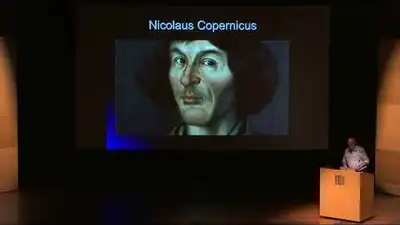
Alien Worlds and the Origins of Science
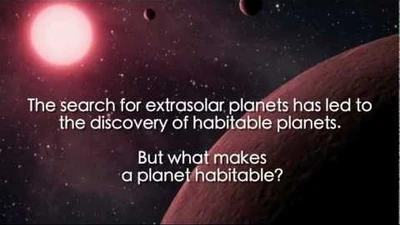
Paul Butler and the Search for Habitable Planets
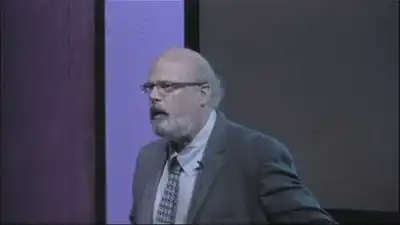
Hunting Planets: Celebrating 20 years of Exoplanets
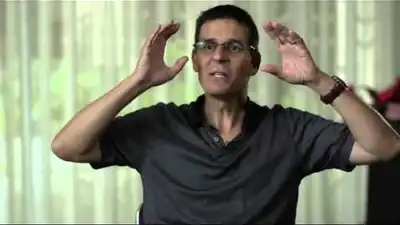
Search for Another Earth
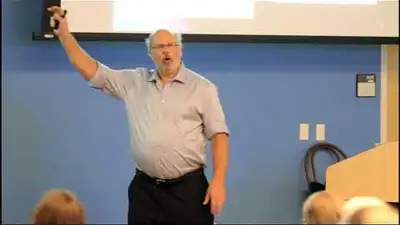
Paul Butler July 2017 Lecture to NOVAC: Exoplanets and the Origins of Science
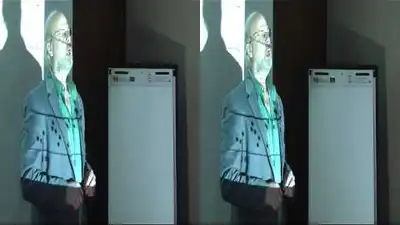
Exosolar Planets - Paul Butler, Carnegie Institution of Washington, DTM
